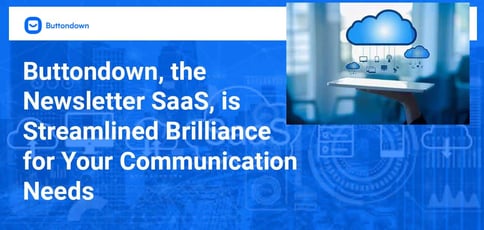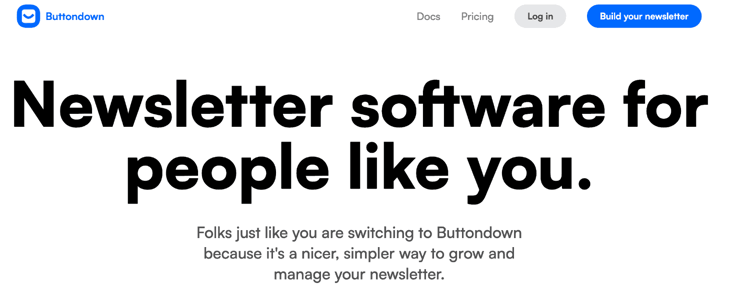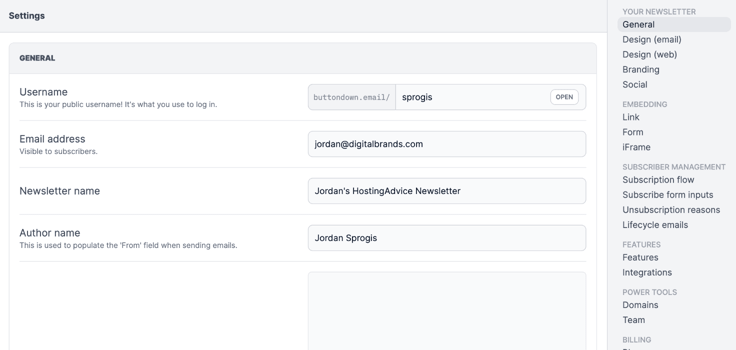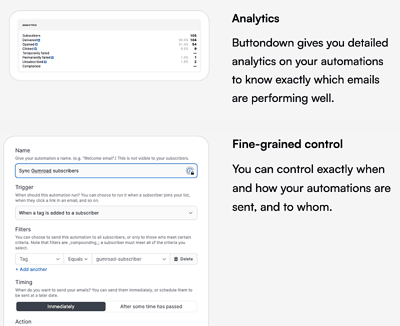
TL; DR: Newsletters have long been a cornerstone of customer communication, providing brands with a direct channel to share updates and promotions. But amid the dozens of email software, Buttondown stands out as a simple, user-friendly solution. Founder Justin Duke told us how the software-as-a-service (SaaS) platform streamlines newsletter publishing while offering robust features such as app integration and automation — all at an affordable price or a cluttered user interface.
I always joke with my husband that I’m the ideal target audience because the simplest marketing techniques work on me. Tell me you’ve added more items to your clearance rack, and I’m already reaching for my wallet. Offer me a limited BOGO deal, and I will fill up my cart twice as fast. Sometimes, it feels like these companies have a direct line to my impulses, and I just can’t resist.
But when I look at the common denominator, I realize I learn about most of these deals and sales through emailed newsletters. While part of me is entirely aware of the subtle manipulation behind attention-grabbing headlines like, “Act fast! Limited time offer!” I still find myself embracing them with surprising eagerness.
Justin Duke, the founder of email newsletter software Buttondown, says the art of email newsletters hasn’t changed much over the past couple of decades.

Buttondown is a software-as-a-service (SaaS) platform for creating and managing email newsletters. It’s a simple yet customizable and effective tool to establish loyal readers and target specific audiences.
Justin believes the technology itself doesn’t have to change — as long as you continue improving the product’s core purpose and keep up with user expectations.
“We try to focus as much as possible on the things that don’t change. All our features are evergreen because people publish newsletters for all types of reasons,” said Justin. “Maybe you’re not excited by playing around with your newsletter, but you might be excited by writing, or you might be excited by working with your subscribers and building a paid audience.”
Scaling Up Customer Base and Features
We last spoke with Justin about a year ago — and in that short time, Buttondown has already gone through impressive leaps and bounds.
For starters, Buttondown has approximately tripled in customer count and revenue. It has also prioritized scaling up the internal team and platform to support the growth and use cases.
“The average author using Buttondown grew a lot, and so a lot of our growth was about making sure that our functionality could scale with them while also ensuring the user experience is the core goal,” said Justin.
Justin emphasized the importance of prioritizing this, and noted a recurring trend where companies may initially concentrate on the basics but gradually become more intricate, often at the expense of preserving the core user experience (UX).
In its early days, Buttondown focused on the “basics and essentials, providing a minimalist and core experience for users.” As the company has grown, it’s worked to add more advanced features without sacrificing that simple core experience, including:
- Automation: Allows things like branching logic workflows that can be triggered based on specific events, such as sending a survey coupon if a user is about to churn
- Comments: Adds the ability for readers to comment on newsletter emails, allowing for community engagement
- Improved editing experiences: Focuses on upgrades to the core writing and editing workflows, taking inspiration from advances in CMS systems like WordPress
Additionally, users can choose between fully migrating to the Buttondown platform or integrating it into their current web interface and using Buttondown exclusively for email newsletter management.
“There’s a ton of email marketing tools out there and ways you can have someone manage your subscribers and all of that for you,” said Justin.
For example, even if you use mega-famous platforms like MailChimp, you may still need an entire team to manage your email marketing efforts.
Another point of focus is customer service.
“It may sound boring,” Justin laughed, “but customer service is one of our top priorities. When we engage with customers, we always ask them why they chose us over the dozens of other newsletter marketing tools, and the overwhelming response we receive is about the quality of our customer service.”
Buttondown’s testimonials hardly beg to differ.
Simplify Newsletter Creation with Easy-to-Use, Powerful Features
Buttondown was created to provide a simple and intuitive core experience for writing and publishing newsletters for creators, businesses, and eCommerce shops. Its goal was to help these publishers enhance long-term subscriber engagement instead of short-term monetization tactics.
One of the best parts about Buttondown is it has a free plan, so you can play around with the basics as much as you’d like without being roped into free trials or accidental subscriptions.
Here’s what you can expect from each plan:
- Free: $0/mo for up to 100 subscribers
- Basic: $9/mo for up to 1,000 subscribers
- Standard: $29/mo for up to 5,000 subscribers
- Professional: $79/mo for up to 10,000 subscribers
- Advanced: $139/mo for up to 20,000 subscribers
- Custom: Infinite number of subscribers with custom pricing
I signed up for Buttondown to get a lay of the land myself, and I vouch that it’s a straightforward yet robust tool. At first glance, the platform is super clean, but I quickly found myself going down the rabbit holes of customization options for my imaginary newsletter.
With plenty of documentation know-how, markdown support, and the ability to customize logos, attachments, and themes for each newsletter, it’s easy to make your newsletter look like your brand.
It integrates tons of apps, including Spotify, Discord, Framer, Medium, and Stripe. One of my favorites is Giphy, which allows me to add some of my favorite “The Office” GIFs directly into the body text.

Buttondown also incorporated new features. Add paid subscriptions, surveys, comments, attachments, and webhooks to customize each newsletter experience.
The automation feature can also be tailored to specific segments of the audience based on their actions, tags, or metadata — which allows for targeted communication. For example, you can set up a flow where someone is about to churn, you can send them a coupon to keep them on the hook.
You can learn more about Buttondown’s features here.
Prioritizing Customer Experience Above All Else
Artificial intelligence (AI) is a feature that, for most tech companies, deserves special attention.
But Buttondown does things differently: Justin notes that AI features are risky due to their non-deterministic elements. If you’ve ever asked ChatGPT the same question more than once and got two wildly different answers, then you know what I’m talking about.
For Buttondown, this means avoiding distractions from trendy tools like AI and instead investing in enhancing the editing and writing experience.

“We’ve found a lot of new use cases for the product, so my overriding goal with where we invest our attention this year is to expand the scope of what it can do,” said Justin. “Next, we want to make sure that that core experience is still even better than it can be.”
There’s also been a shift in how newsletters are used. Instead of boosting community engagement and brand awareness, they’re seen as crucial revenue-generating tools.
Justin pointed out this change as publishers focus on strategies like adding paid subscriptions, seeking sponsorships, and investing in paid ads.
While community engagement remains crucial for a brand, this shift isn’t harmful. Ultimately, it’s a two-step process: Newsletters help increase brand awareness, which leads to more sales.
Justin says Buttondown remains committed to prioritizing its customers’ needs.
“Even as the industry becomes a little bit more monetization driven, we want to make sure that the folks trying to build authentic long-term audiences are being served well,” he said.



